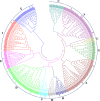"Genome-wide identification of bZIP gene family in Pearl millet and transcriptional profiling under abiotic stress, phytohormonal treatments; and functional characterization of PgbZIP9"
- PMID: 38469329
- PMCID: PMC10925649
- DOI: 10.3389/fpls.2024.1352040
"Genome-wide identification of bZIP gene family in Pearl millet and transcriptional profiling under abiotic stress, phytohormonal treatments; and functional characterization of PgbZIP9"
Abstract
Abiotic stresses are major constraints in crop production, and are accountable for more than half of the total crop loss. Plants overcome these environmental stresses using coordinated activities of transcription factors and phytohormones. Pearl millet an important C4 cereal plant having high nutritional value and climate resilient features is grown in marginal lands of Africa and South-East Asia including India. Among several transcription factors, the basic leucine zipper (bZIP) is an important TF family associated with diverse biological functions in plants. In this study, we have identified 98 bZIP family members (PgbZIP) in pearl millet. Phylogenetic analysis divided these PgbZIP genes into twelve groups (A-I, S, U and X). Motif analysis has shown that all the PgbZIP proteins possess conserved bZIP domains and the exon-intron organization revealed conserved structural features among the identified genes. Cis-element analysis, RNA-seq data analysis, and real-time expression analysis of PgbZIP genes suggested the potential role of selected PgbZIP genes in growth/development and abiotic stress responses in pearl millet. Expression profiling of selected PgbZIPs under various phytohormones (ABA, SA and MeJA) treatment showed differential expression patterns of PgbZIP genes. Further, PgbZIP9, a homolog of AtABI5 was found to localize in the nucleus and modulate gene expression in pearl millet under stresses. Our present findings provide a better understanding of bZIP genes in pearl millet and lay a good foundation for the further functional characterization of multi-stress tolerant PgbZIP genes, which could become efficient tools for crop improvement.
Keywords: ABI5 (ABA insensitive 5); abiotic stress; bZIP transcription factors; pearl millet; plant genomics.
Copyright © 2024 Jha, Chanwala, Barla and Dey.
Conflict of interest statement
The authors declare that the research was conducted in the absence of any commercial or financial relationships that could be construed as a potential conflict of interest.
Figures










Similar articles
-
Genome-wide analysis of bZIP transcription factors and their expression patterns in response to methyl jasmonate and low-temperature stresses in Platycodon grandiflorus.PeerJ. 2024 Apr 30;12:e17371. doi: 10.7717/peerj.17371. eCollection 2024. PeerJ. 2024. PMID: 38708338 Free PMC article.
-
Comprehensive identification and expression analysis of GRAS gene family under abiotic stress and phytohormone treatments in Pearl millet.Funct Plant Biol. 2021 Sep;48(10):1039-1052. doi: 10.1071/FP21051. Funct Plant Biol. 2021. PMID: 34266539
-
MYB Transcription Factor Family in Pearl Millet: Genome-Wide Identification, Evolutionary Progression and Expression Analysis under Abiotic Stress and Phytohormone Treatments.Plants (Basel). 2023 Jan 12;12(2):355. doi: 10.3390/plants12020355. Plants (Basel). 2023. PMID: 36679070 Free PMC article.
-
Pearl Millet: A Climate-Resilient Nutricereal for Mitigating Hidden Hunger and Provide Nutritional Security.Front Plant Sci. 2021 Sep 13;12:659938. doi: 10.3389/fpls.2021.659938. eCollection 2021. Front Plant Sci. 2021. PMID: 34589092 Free PMC article. Review.
-
Exploration of Genetic and Genomic Resources for Abiotic and Biotic Stress Tolerance in Pearl Millet.Front Plant Sci. 2017 Jan 23;7:2069. doi: 10.3389/fpls.2016.02069. eCollection 2016. Front Plant Sci. 2017. PMID: 28167949 Free PMC article. Review.
Cited by
-
A pearl millet plasma membrane protein, PgPM19, facilitates seed germination through the negative regulation of abscisic acid-associated genes under salinity stress in Arabidopsis thaliana.Planta. 2024 Nov 2;260(6):131. doi: 10.1007/s00425-024-04564-2. Planta. 2024. PMID: 39488664
-
Genome-wide analysis of the laccase gene family in tossa jute (Corchorus olitorius): insights into stem development, lignification, and responses to abiotic stress.Front Plant Sci. 2025 May 9;16:1568674. doi: 10.3389/fpls.2025.1568674. eCollection 2025. Front Plant Sci. 2025. PMID: 40416091 Free PMC article.
-
Analysis of plant pararetrovirus promoter sequence(s) for developing a useful synthetic promoter with enhanced activity in rice, pearl millet, and tobacco plants.Front Plant Sci. 2024 Aug 6;15:1426479. doi: 10.3389/fpls.2024.1426479. eCollection 2024. Front Plant Sci. 2024. PMID: 39166238 Free PMC article.
-
Identification and expression analysis of bZIP transcription factors in Setaria italica in response to dehydration stress.Front Genet. 2024 Aug 30;15:1466486. doi: 10.3389/fgene.2024.1466486. eCollection 2024. Front Genet. 2024. PMID: 39280094 Free PMC article.
-
Comprehensive analysis of housekeeping genes, tissue-specific genes, and dynamic regulation across developmental stages in pearl millet.BMC Genomics. 2024 Dec 18;25(1):1199. doi: 10.1186/s12864-024-11114-3. BMC Genomics. 2024. PMID: 39695372 Free PMC article.
References
-
- Ahmad P., Prasad M. N. V. (2011). Environmental adaptations and stress tolerance of plants in the era of climate change. (New York: Springer Science & Business Media; ).
-
- Banerjee A., Roychoudhury A. (2017). Abscisic-acid-dependent basic leucine zipper (bZIP) transcription factors in plant abiotic stress. Protoplasma 254, 3–16. - PubMed
-
- Baoling L., Li Z., Yan S., Jinai X., Changyong G., Lixia Y., et al. . (2016). Genome-wide identification of millet bZIP transcription factors and their expression analysis under drought and salt stress. Acta Botani Sin. 51, 473–487.
LinkOut - more resources
Full Text Sources
Miscellaneous

